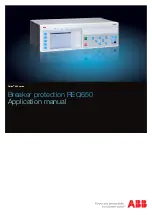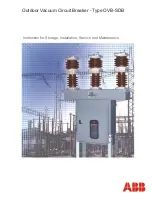
EntelliGuard G
TRIP UNIT
OPER
A
TION
2
.2
specifically assigned connection points located
on the standard terminal block fitted on the top
of the EntelliGuard circuit breaker.
The GT-H Trip Units are avail
a
ble in two different
versions, one fully compliant with the Modbus
Protocol and one fully compliant with the
Profibus Protocol .
Full details of the Modbus protocol can be found
in the Modbus Protocol Specification.
Two wire Modbus is supported.
The link Host may operate at a 300, 600, 1200,
2400, 4800, 9600 or 19200-baudrate.
ProfiBus DP over RS485 is supported. All
registers can be read or write using a cyclic
mode. _
An overview of the communication parameters
and register is included in Section 2.5 of this
manual.
2.2.8 Thermal Memory
The thermal memory is a means to simulate
temperature rise and cooling caused by
changes in the flow of current in the conductors.
These changes may be caused by:
-- Repetitive motor starting;
-- Loads fluctuating near the protection settings;
-- Repeated circuit breaker closing on a fault.
Even very short overloads or short circuits can
produce a certain temperature rise. During
normal operations these event are tracked and
stored in thermal memory resulting in a
reduction in the total circuit breaker tripping
time.
If the Circuit Breaker has tripped on a
overcurrent event the thermal effects of the
current previously running in the circuit will be
taken into account. (remembered). This can
result in a prevention of breaker re-closure onto
a circuit running in 'Hot conditions' or cause the
mentioned reduction in the total tripping time
after re-closure.
The trip unit tracks these occurrences across a
time frame of 12 minutes.
When set to cyclic mode a limited
number of parameters is available, please
contact us for more information.
dem Hilfstrennblock im oberen Schalterbereich
hergestellt.
Die GT-H Auslöseeinheiten sind in zwei
verschiedenen Varianten verfügbar, jeweils mit
dem Modbus-Protokoll oder aber dem Profibus-
Protokoll voll kompatibel.
Alle Details über die Modbus-Protokoll finden Sie
in der Modbus-Protokoll-Spezifikation.
Zwei Draht-Modbus wird unterstützt.
Der Hostlink arbeitet mit einer 300, 600, 1200,
2400, 4800, 9600 oder 19200 Baudrate.
ProfiBus DP über RS485 wird unterstützt. Alle
Register können im azyklischen Modus gelesen
oder geschrieben werden. In diesem Modus ist
aber nur eine limitierte Anzahl der Parameter
verfügbar. Gern stehen wir Ihnen für weitere
Informationen zur Verfügung.
Eine Übersicht über die Kommunikations-
Parameter und Register ist Teil dieses
Handbuchs in Abschnitt 2.5.
2.2.8 Thermische Speicherung
Die -Thermische Speicherung- ist ein Mittel zur
Simulation von Temperaturanstieg und Kühlung,
die durch Lastkraftschwankungen in den Leitern
vorkommen.
Diese Veränderungen kommen vor, durch:
-- sich wiederholende Motorstarts;
-- Lastschwankungen in der Nähe der
Schutzeinstellungen;
-- wiederholte Leistungsschalter-Schließungen
auf Störungen.
Auch sehr kurze Überlast- oder Kurzschlüsse
können bestimmte Temperaturanstiege
produzieren. Im normalen Betrieb werden diese
Vorgänge verfolgt und im thermischen Speicher
gesichert, was zu einer Verringerung der
Leistungsschalter-Gesamtauslösezeit führt.
Wenn der Leistungsschalter wegen einem
Überstromvorfall ausgelöst hat, wird der
thermische Effekt der aktuellen, zuvor
abgelaufenen Schaltungen berücksichtigt.
(Erinnerungseffekt). Dies führt zur Vermeidung
von Wiedereinschaltungen auf eine Schaltung,
die unter 'heißen Bedingungen' läuft oder führt
dazu, dass die erwähnte Kürzung der Gesamt-
Auslösezeit nach Wiedereinschaltung eintritt.
Die Auslöseeinheit speichert dies Vorgänge
innerhalb eines Zeitfensters von 12 Minuten.
standardowej listwie zaciskowej umieszczonej w
górnej części wyłącznika EntelliGuard.
Wyzwalacze nadprądowe GT-H są dostępne w
dwóch różnych wersjach: jedna z nich jest w
pełni kompatybilna z protokołem Modbus, druga
w pełni kompatybilna z protokołem Profibus.
Szczegółowe informacje na temat protokołu
Modbus można znaleźć w jego specyfikacji
technicznej.
Możliwa jest współpraca z dwuprzewodową
magistralą Modbus. Jednostka nadrzędna może
pracować z prędkościami 300, 600, 1200, 2400,
4800, 9600 lub 19200 [baud].
Możliwa jest współpraca z magistralą Profibus
DP poprzez złącze RS485. Wszystkie rejestry
mogą być odczytywane lub zapisywane przy
użyciu
transmisji asynchronicznej
.
Przegląd parametrów i rejestrów
komunikacyjnych jest przedstawiony w
Rozdziale 2.5 tej instrukcji.
2.2.
8
Pamięć termiczna
Pamięć termiczna umożliwia symulację wzrostu i
obniżenia temperatury w zależności od wartości
płynącego prądu.
Zmiany te mogą być spowodowane przez:
-- Wielokrotne uruchamianie silników;
-- Obciążenia zmienne, utrzymujące się w
pobliżu nastaw zabezpieczeń;
-- Kilkakrotne zamykanie wyłącznika na zwarcie.
Nawet bardzo krótkie przeciążenia lub zwarcia
mogą powodować wzrost temperatury. Podczas
zwykłej pracy urządzenia takie zdarzenia mogą
być monitorowne i rejestrowane w pamięci
termicznej, dzięki czemu może ulec skróceniu
całkowity czas otwierania wyłącznika przez
wyzwalacz.
Jeśli wyłącznik został otwarty przez wyzwalacz
na skutek przeciążenia skutki termiczne
wcześniejszego przepływu prądu będą
uwzględniane (pamiętane) w jego dalszym
działaniu. W ten sposób można uniknąć
ponownego zamknięcia wyłącznika w
rozgrzanym już obwodzie, lub uzyskać
wspomniane skrócenie całkowitego czasu
wyzwalania po ponownym zamknięciu.
Wyzwalacz uwzględnia zdarzenia z ostatnich
12 minut.
2-23













































